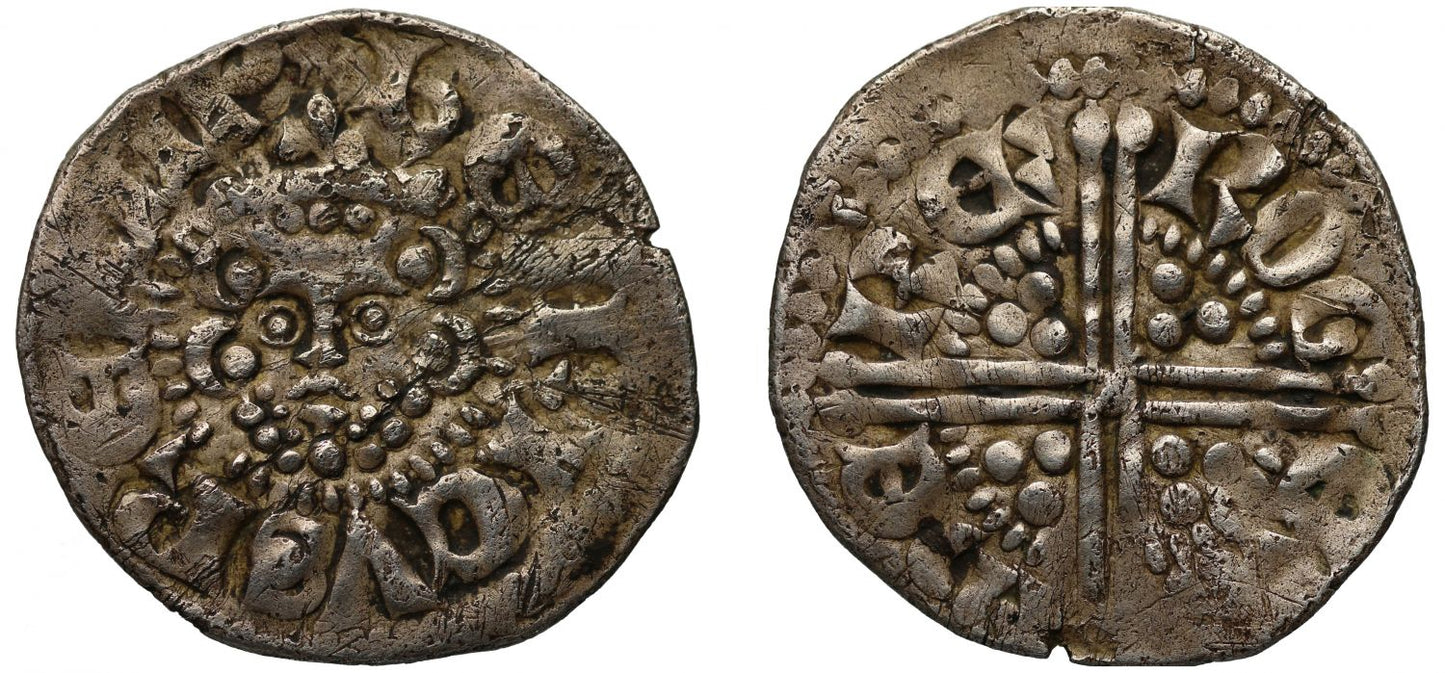FAQs
What makes a coin valuable?
I have coins to sell, what’s the next step?
How will my purchases be shipped?
What happens if I’m not entirely happy with my purchase?
Henry III Long cross Penny, type 3b, Hereford Mint, Moneyer Roger
Henry III (1216-72), silver Penny, Phase II (1248-50), voided long cross type, class 3b (c.1248), Hereford Mint, moneyer Roger, neat facing crowned head, legend commences at top with inner and outer beaded border surrounding, initial mark six pointed star, +hENRICVS REX. III', rev. long voided cross pommée, trio of pellets in each angle, legend surrounding with inner and outer beaded border, ROGER ON HER, weight 1.35g (N.987; S.1363). Toned, weak at periphery, some porosity, about very fine and rare.
The Latin legends translate as on the obverse "King Henry the Third" and on the reverse as "Roger of Hereford."
In an effort to curtail clipping of the edges if coins, Henry III was the first to introduce a coinage where the reverse cross extended to towards the rim of the coin so any tampering of the edge would be more obvious to the casual observer. The new design having a voided cross pommée with groups of three pellets in each inner angle. The coinage running for a 32 year period from 1247 until 1279 in the reign of Edward I. The London Mint operated with up to 11 moneyers which was one more than the 10 at Canterbury and run through 5 different classes in this reign with multiple sub-classes and varieties, transitioning into two more later classes in the reign of Edward I.
Nine year old Henry who was born on 1st October 1207 succeeded his Father under the protection of William Marshall on 28th October 1216 with a coronation at Gloucester Cathedral and who reintroduced the terms of the Magna Carta from 1217, after quelling the Baron's rebellion at the battles of Lincoln and Sandwich, under which all future government was based.
At age 18 in 1225 Henry agreed to abide by the Great Charter which was a later version of the Magna Carta limiting Royal power and protecting the barons. Henry was also Lord of Ireland and Duke of Aquitaine and attempted to regain lands in France in 1230 to no avail. A revolt in 1232 by Richard Marshall the son of William was ended by a peace settlement with interaction from the church. Henry preferred to home rule and married Eleanor of Provence in 1236 with whom he had five children, the eldest being the future King Edward I. He was known for piety and charity and adopted Edward the Confessor as his patron saint. He did try invading Poitou in 1242 but suffered defeat at the Battle of Taillebourg and by 1258 his rule at home was becoming unpopular over foreign policy and taxes. A coalition of barons seized power expelling Henry's Poitevin half-brothers and reforming government with the Provisions of Oxford. Henry with the baronial government enacted peace with France in 1259 giving up lands in France in exchange for Louis IX recognising him as ruler of Gascony, but instability later continued. In 1263 the baron Simon De Montfort seized power resulting in a second Baron's War with Henry receiving support from Louis and culminating in the Battle of Lewes in 1264 where Henry was defeated and taken prisoner. Henry's sone Prince Edward came to the rescue by defeating De Montfort killing him at the Battle of Evesham in 1265 and freed King Henry. Henry wanted to exact revenge on the rebels but was persuaded by the church through the Dictum of Kenilworth of 31st October 1266 to take a less harder line and reconcile. Henry died after recurring illness on 16th November 1272 after the longest Medieval reign in English history and is buried in Westminster Abbey.
Nearly 150 miles north west of London on the River Wye a garrison was established here before 914 and a year after the men of Hereford defeated the Danes. The seat of its own Bishop since early times, the city grew though it was plundered and burnt in 1055 by Earl Algar right in the middle of the building of a castle. Hereford was later a stronghold for Robert of Gloucester that capitulated to King Stephen in 1138. In the Barons War Prince Edward was imprisoned here.
Provenance:
Ex Collection of an English Doctor part III, Sovereign Rarities fixed price list online August 2022.
FAQs
What makes a coin valuable?
I have coins to sell, what’s the next step?
How will my purchases be shipped?
What happens if I’m not entirely happy with my purchase?













